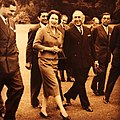Monarchy of Pakistan
From 1947 to 1956, the Dominion of Pakistan was a self-governing country within the Commonwealth of Nations that shared a monarch with the United Kingdom and the other Dominions of the Commonwealth. The monarch's constitutional roles in Pakistan were mostly delegated to a vice-regal representative, the governor-general of Pakistan.
Not to be confused with Princely states of Pakistan.Monarchy of Pakistan
The dominion was created by the Indian Independence Act 1947, which divided British India into two independent sovereign states of India and Pakistan. The monarchy was abolished on 23 March 1956, when Pakistan became a republic within the Commonwealth with a president as its head of state.
Vice-regal residences[edit]
The representative of the Pakistani monarch officially resided at Governor-General's House, in the city of Karachi. All four governors-general lived there until 1956, when the monarchy was abolished, and the residence was renamed President's House.[54]
All oath taking ceremonies were held at the Darbar Hall of Governor-General's House. The Hall also contains a throne which was made for King Edward VII during his tour of India as Prince of Wales in 1876, and was also used by Queen Mary during the Delhi Durbar in 1911. All governors-general took salutes at the terrace of the house on national days as the contingents of guards marched past.[54]
Cultural role[edit]
The Crown and Honours[edit]
Within the Commonwealth realms, the monarch is deemed the fount of honour.[55] Similarly, the monarch, as Sovereign of Pakistan, conferred awards and honours in Pakistan in his or her name. Most of them were awarded on the advice of "His Majesty's Pakistan Ministers" (or "Her Majesty's Pakistan Ministers").[56][57][58]


